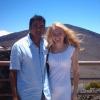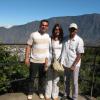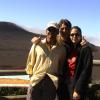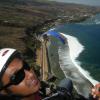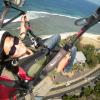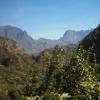The classic excursions
Main sites
CILAOS CIRQUE
An Island in an
Higher altitude:
Temperatures: 12 to
What to wear: good shoes or walking boots, rainwear, pullover, and sun lotion.
07.00am Departure to the south of the island. First stop at the « blower » along the rocky coast to admire beautiful kind of white foam geysers, resembling a whale’s spout.
The pretty
In
The ascent by the “400 bends road” offers exceptional lookout points with breathtaking views of the several hamlets.
When you finally reach the village dominated by the highest summits (the majestic Piton des Neiges 3070m, Grand Bénare 2896m, Trois Salazes 2121m), you’ll feel as if you were exploring a village of yore, with its old houses surrounded by flowery yards and gardens which in the hot season, look like a colourful artist palette: jacarandas with mauve shadings, dahlias, azaleas, roses, hydrangeas, mimosas… Cilaos is also famous for its hydropathy establishment, its magnificent embroidery, its wine (the only one produced in
After a Creole lunch, you’ll visit the “Embroidery House” and discover “les Jours de Cilaos”. On the way back, in the late afternoon, you’ll stop at “the whirlpool“ at L’Etang-Salé, and return to your hotel around 5.30pm
SALAZIE CIRQUE
A tropical garden
Higher altitude:
Temperatures: 12 to
What to wear: good shoes or walking boots, rainwear, pullover, sun lotion and mosquito lotion.
07.30am Departure to the north of the island, taking the coastal road to
Then, you’ll enter in the largest, the greenest and the wettest cirque of the three (owing to its windward position). Salazie, a refuge of fugitive slaves or “runaways” was late colonized. Inviolate for a long time, this cirque is accessible by the only hemmed road running along Rivière du Mât. You find very quickly an imposing garden of verdure and cascades, in particular the “Voile de la Mariée” (wedding veil). Its charm derives from the existing harmony between its waters flowing down a hundred cascades, its omnipresent lush vegetation, its imposing relief made softer by all the greenery, and the man-made buildings that blend in with the landscape. Everything grows there, but you’ll notice in particular banana trees, bamboos and various vegetables cultivation like watercress, and the most well known is « chouchou », imported from Mexico in 1840. Arrival to Hell-Bourg: the village was awarded in 1998 the title for one of the most beautiful
Return to your hotel around 5.30pm.
VOLCANO « The
A surprising mineral world
Higher altitude: 2360 metres
Temperatures: 3 to
What to wear: good shoes or walking boots, rainwear, hat, pullover, and sun lotion.
07.00am Departure to the south of the island, at the beginning of the South-East coast through Tampon, by driving back up to “Plaine des Cafres”, a cattle-breeding area (bovine, sheep) dotted with brooms, old tamarind trees and acacias. The scenery in the High Plains is magnificent. Bourg-Murat is the starting point to take the forest road from where you’ll enjoy the numerous sights, particularly the “Nez de Boeuf” (Ox’s Nose) with a panorama over “Rivière des Remparts”. The edges of this canyon are the witnesses of the first “caldeira” (depression in a circular form) caused by the falling-down of the summit of “Piton de la Fournaise”. When you continue, you discover a lunar landscape, “Plaine des Sables” (the sands plain), born from the falling-down of the second volcano which built itself into the caldeira. After Plaine des Sables, the road goes on in-between the distorted ruins of ancient craters up to the last bluff before the central volcano site. Here, from the edge of a 300-metre high “Pas de Bellecombe” belvedere (2311m), you can gaze at the almost prefect cone of La Fournaise, culminating at 2631m.
A path along Pas-de-Bellecombe leads down into this absolutely fascinating “enclosure”: 1 hour walking for the first crater “Formica Léo”, and around 5 h walking for the main craters “Bory” and “Dolomieu”. On the way back by the same cinder track, you stop over the “Commerson Crater” which results of a volcanic explosion.
After a Creole lunch, you visit the Volcano House (designed by Maurice and Katia Kraft), a must for all those who want to find out more about volcanoes. The permanent exhibition provides information on the geological formation of the island, on volcano-related risks and the way they are controlled. At the end of the road leading to “Bois-Court”, you get a memorable visual dive down of “Grand Bassin” huge valley.
Return to your hotel around 5.30pm.
THE WILD SOUTH COAST
The blue, the black and the green
(Except on Tuesdays)
Higher altitude:
Temperatures: 22 to
What to wear: good shoes or walking boots, rainwear, pullover, mosquito lotion and sun lotion.
07.30am Departure in direction of Saint-Pierre, where the leeward coast becomes the windward coast and takes another colours and a very special animated atmosphere. You follow the road to “Grand Anse” creek, with its beach bordered with coconut palms, a real heaven of peace. Every weekend, the brand newly married couple investigate the place for the pictures. The many lookout points afford the enjoyment of discovering this charming part of the island: Manapany, Langevin, and “Cap Méchant”: there the ocean crashes in impressive waves against the jagged black lava cliffs. A little bit farther, crossing the bottom part of the coloured wood forest, you discover, at the foot of the volcano, the recent lava flows. A total landscape breaking up with the “
In Sainte-Rose zone, you stop at “Anse des Cascades” (waterfall cove), with its tiny fishing-boats landing sites and at Piton Sainte-Rose, where the church “Notre Dame des Laves” has been miraculously frozen around by the
On the way back, and after a Creole lunch in the surroundings of Saint-Philippe, you visit a wonderful and wild botanical garden: “le Jardin des parfums et des épices”. (Spice and fragrance garden). You’ll explore hundreds of species of native exotic plants including many medicinal, ornamental and fruit spices, some of which being a century old. A guide with a perfect knowledge of the garden and of its history will take you round the place and initiate you to the manual pollination of the vanilla flower (October to January).
Return to your hotel around 5.30pm.
ISLAND TOUR
Welcome to paradise
Higher altitude:
Temperatures: 22 to
What to wear: good shoes or walking boots, rainwear, pullover, mosquito lotion and sun lotion.
07.00am Departure to the North and the East coast to run along the big sugar cane fields.
You stop first at “Sainte-Anne Church”, unique on the island, with its outside cement ornaments made by hand by the church’ goers 140 years ago. On this road you also go through litchi, jamalac and pineapple fields. The houses are more rare and in a pure Creole-style with their colours and inimitable well-kept gardens. You cross numerous rivers of which the East River which was crossed in the past by the “
After Sainte-Rose, you stop first at “Notre Dame des Laves” that has been miraculously frozen around by the
Secondly, the paradise waterfall cove “Anse des Cascades” with its tiny fishing-boats landing sites. The exuberated vegetation of the place will make way for the “
After Creole lunch, you will discover the district of Saint-Philippe offering the biggest natural reserve of the island (vacoas, filaos, coloured-woods, cabbage trees…).
In the surroundings you visit “le Jardin des parfums et des épices” (Spice and fragrance garden) with a guide with a perfect knowledge of the garden’s secrets and history. You explore hundreds of species of native exotic plants including many medicinal, ornamental and fruit spices, some of which being a century old.
A stop at “Cap Méchant” (Bad Cap) will show you a volcanic promontory famous for its impressive waves crashing onto the jagged lava cliffs.
When taking the road again to the West Coast, you stop at “the Whirlpool” at L’Etang-Salé. There the vegetation is completely different and reminds us that we are on the leeward coast again. Arrival at your hotel around 5.30pm.

